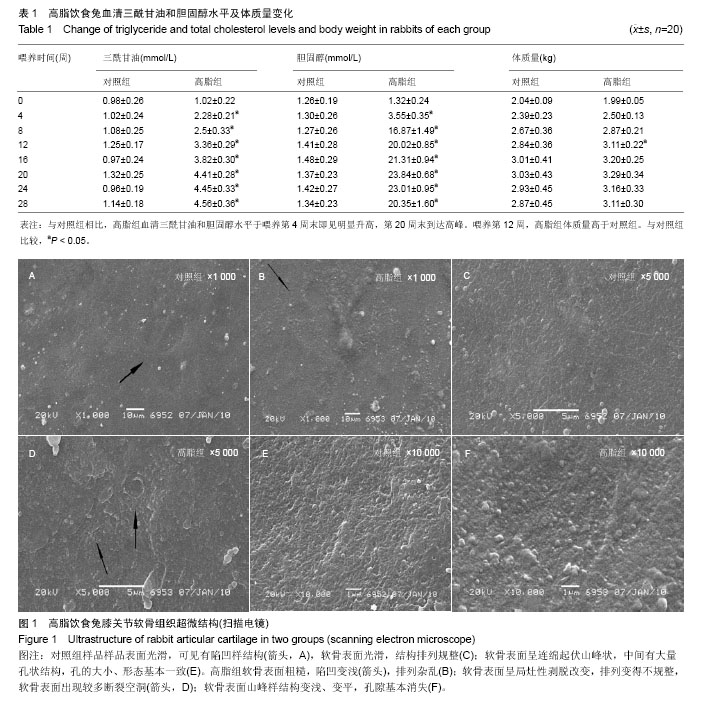| [1] 马建兵.兔实验性膝骨性关节炎的组织病理学及发病机理[J].中国矫形外科杂志,2001,8(1)45-47.
[2] Silberberg R, Silberberg M. Skeletal growth and articular changes in mice receiving a high-fat diet. Am J Pathol. 1950; 26(1):113-131.
[3] Saudek DM, Kay J. Advanced glycation endproducts and osteoarthritis. Curr Rheumatol Rep. 2003;5(1):33-40.
[4] 娄思权.骨关节炎的病理与发病因素[J].中华骨科杂志, 1996, 16(1):56.
[5] Soren A, Cooper NS, Waugh TR. The nature and designation of osteoarthritis determined by its histopathology. Clin Exp Rheumatol. 1988;6:41-46.
[6] Jeffery AK, Blunn GW, Archer CW, et al. Three-dimensional collagen architecture in Bovine articular cartilage. J Bone Joint Surg Br. 1991;73(5):795-801.
[7] 邱贵兴.骨关节炎流行病学和病因学新进展[J].继续医学教育, 2005,19(7):68-69.
[8] Silberberg R, Aufdermaur M, Hasler M. Ultrastructural changes in articular chondrocytes of mice fed a lard-enriched diet. Anat Rec. 1970;166(3):447-467.
[9] Elizalde M, Ryden M, van Harmelen V. Expression of nitric oxide synthases in subcutaneous adipose tissue of nonobese and obese humans. J Lipid Res. 2000;41(8):44-51.
[10] Fries DM, Penha RG, D'Amico EA. Oxidized low density lipop rotein stimulates nitric oxide release byrabbit aortic endothelial cells. Biochem Biopys Res Commum. 1995; 207(1):31-37.
[11] 刘红燕,贾汝汉,丁国华.高脂血症大鼠肾脏一氧化氮变化及其意义[J].同济医科大学学报,1999,28(2):120.
[12] 杨牧祥,田元祥,马金庆,等.脂调康胶囊对高脂血症大鼠血清一氧化氮的影响[J].中国中医药信息杂志,2003,10:33-34.
[13] Hashimoto S, Takahashi K, Amiel D, et al. Chondrocyte apoptosis and nitic oxide production during experimentlly induced osteoarthristis. Arthritis Rheum. 1998;41(7): 1266-1274.
[14] Xu Y, Dai GJ, Liu Q, et al. Sanmiao formula inhibits chondrocyte apoptosis and cartilage matrix degradation in a rat model of osteoarthritis. Exp Ther Med. 2014;8(4): 1065-1074.
[15] Peck Y, Ng LY, Goh JY, et al. A three-dimensionally engineered biomimetic cartilaginous tissue model for osteoarthritic drug evaluation. Mol Pharm. 2014;11(7): 1997-2008.
[16] Mawatari T, Nakamichi I, Suenaga E, et al. Effects of heme oxygenase-1 on bacterial antigen-induced articular chondrocyte catabolism in vitro. J Orthop Res. 2013;31(12): 1943-1949.
[17] Pascarelli NA, Moretti E, Terzuoli G, et al. Effects of gold and silver nanoparticles in cultured human osteoarthritic chondrocytes. J Appl Toxicol. 2013;33(12):1506-1513.
[18] Cheng W, Wu D, Zuo Q, et al. Ginsenoside Rb1 prevents interleukin-1 beta induced inflammation and apoptosis in human articular chondrocytes. Int Orthop. 2013;37(10): 2065-2070.
[19] Hogrefe C, Joos H, Maheswaran V, et al. Single impact cartilage trauma and TNF-α: interactive effects do not increase early cell death and indicate the need for bi-/multidirectional therapeutic approaches. Int J Mol Med. 2012;30(5):1225-1232.
[20] Kimura H, Yukitake H, Suzuki H, et al. The chondroprotective agent ITZ-1 inhibits interleukin-1beta-induced matrix metalloproteinase-13 production and suppresses nitric oxide-induced chondrocyte death. J Pharmacol Sci. 2009; 110(2):201-211.
[21] Shang L, Qin J, Chen LB, et al. Effects of sodium ferulate on human osteoarthritic chondrocytes and osteoarthritis in rats. Clin Exp Pharmacol Physiol. 2009;36(9):912-918.
[22] Feelisch M. The chemical biology of nitric oxide--an outsider's reflections about its role in osteoarthritis. Osteoarthritis Cartilage. 2008;16 Suppl 2:S3-S13.
[23] Lee MS, Tu YK, Chao CC, et al. Inhibition of nitric oxide can ameliorate apoptosis and modulate matrix protein gene expression in bacteria infected chondrocytes in vitro. J Orthop Res. 2005;23(2):440-445. |
